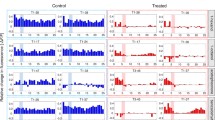Abstract.
The role of honeybee central brain structures, suspected to be cholinergic, has been studied in learning and memory. The nicotinic antagonist mecamylamine and the muscarinic antagonist scopolamine were locally injected into the calyces and the α-lobes of mushroom bodies, and their effects on memory acquisition and retrieval were investigated using one-trial olfactory conditioning of the proboscis extension reflex. A strong impairment of the olfactory learning was noticed following mecamylamine injection into the mushroom body calyces. Mecamylamine and scopolamine disturbed retrieval processes when injected into the α-lobes of mushroom bodies but remain without effect on these processes when injected into the mushroom body calyces. These results emphasise the role of the cholinergic networks of the mushroom bodies in the formation and recall of memory in the honeybee. They suggest that the role of the brain structures in these processes is sequential. Mushroom body calyces involved in the associative process of olfactory learning could be relayed by the α-lobes for information retrieval.
Similar content being viewed by others
Author information
Authors and Affiliations
Additional information
Electronic Publication
Rights and permissions
About this article
Cite this article
Lozano, V., Armengaud, C. & Gauthier, M. Memory impairment induced by cholinergic antagonists injected into the mushroom bodies of the honeybee. J Comp Physiol A 187, 249–254 (2001). https://doi.org/10.1007/s003590100196
Accepted:
Issue Date:
DOI: https://doi.org/10.1007/s003590100196




